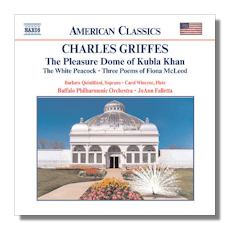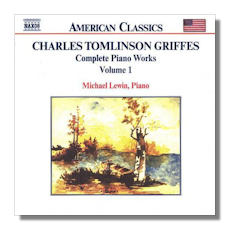
The Internet's Premier Classical Music Source
Related Links
-
Find CDs & Downloads
Amazon - UK - Germany - Canada - France - Japan
ArkivMusic - CD Universe
Find DVDs & Blu-ray
Amazon - UK - Germany - Canada - France - Japan
ArkivMusic-Video Universe
Find Scores & Sheet Music
Sheet Music Plus -
Recommended Links
Site News
Charles Tomlinson Griffes

(1884 - 1920)
One of the few previous American composers recognized by Aaron Copland as any good, Charles Tomlinson Griffes (September 17, 1884 - April 8, 1920) became rather a sport, due mainly to his all-too-short life. He began as a pianist and managed to study in Berlin, from 1903 to 1906. Although recognized as a promising player, he became more interested in composition and studied briefly with Engelbert Humperdinck (of Hansel and Gretel fame), among others. As shown by his early Symphonische Phantasie (1907), he received a thorough training.
Composers, however, need both technique and talent. Griffes had a lot of both. Returning to the United States in 1907, Griffes became music director at a boys' school in Washington Irving's Tarrytown, New York, where he remained for the rest of his life. There he had the space and time to compose. Summers he spent in New York City, writing and promoting his music. For a fellow tucked away most of the year in sleepy Tarrytown, he received not only a good number of performances during his life, but a large dissemination of his music through sheet music.
Until about 1910, he wrote in a Late Romantic, Straussian style. However, he listened to the latest developments and moved on to a very personal adoption of French Impressionism. This period produced his best-known works: The White Peacock, The Pleasure Dome of Kublai Khan, Clouds, Bacchanale, and the Poem for Flute and Orchestra. Many of these scores originally appeared in versions for piano. Less known, unfortunately, are his pieces inspired by Chinese and Japanese culture, especially the 5 Poems of Ancient China and Japan, Komori uta, Noge no yama, and Sho-jo.
However, the Piano Sonata (1918), perhaps his masterpiece, and songs like The Sorrow of Mydath and 3 Poems of Fiona MacLeod – the height of his art as a songwriter – indicate a musical mind ready to move on. With these scores, Griffes leaves Impressionism behind for a tough Modern, thoroughly individual idiom. Unfortunately, his death at 36 put paid to this development and created one of the great what-ifs of American music. ~ Steve Schwartz
Recommended Recordings
 Orchestral & Vocal Works
Orchestral & Vocal Works
- The White Peacock, 3 Poems by Fiona MacLeod, Bacchanale, Clouds, Tone-Pictures, Poem, The Pleasure-Dome of Kubla Khan/Naxos 8.559164
-
Barbara Quintiliani (soprano), Carol Wincenc (flute), JoAnn Falletta/Buffalo Philharmonic Orchestra
- An den Wind, Am kreuzweg wird begraben, Meeres Stille, Auf geheimen Waldespfade, 4 Impressions, Song of the Dagger, The Pleasure-Dome of Kubla Khan, 3 Poems by Fiona MacLeod, Tone-Pictures/New World Records 80273-2
-
Sherrill Milnes (baritone), Jon Spong (piano), Olivia Stapp (mezzo soprano), Diane Richardson (piano), Phyllis Bryn-Julson (soprano), Seiji Ozawa/Boston Symphony Orchestra
Piano Music
- Sonata, Tone Pictures, De profundis, Roman Sketches, A Winter Landscape, Rhapsody, Barcarolle, Legend, Prelude/Naxos 8.559023
-
Michael Lewin (piano)
- Pleasure-Dome of Kubla Khan, Preludes, Dance, Fantasy Pieces, Hansel and Gretel Overture, Symphonische Phantasie/Naxos 8.559046
-
Michael Lewin (piano)















